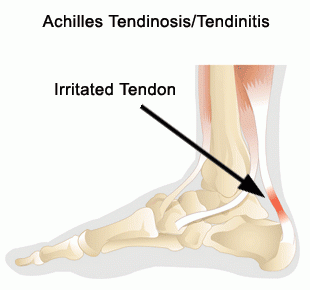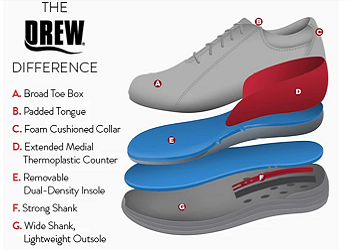Achilles Tendonitis
What Is Achilles Tendonitis?
It is inflammation of the Achilles tendon, which is a band of fibers that runs from the lower calf to the top of the heel. It connects the muscles in the back of the leg (gastrocnemius and soleus) to the heel bone or calcaneus.

What Are the Symptoms of Achilles Tendonitis?
Pain is the major symptom. The area may be tender and slightly swollen. Some redness may be present, but usually, the only symptom is pain.
The pain occurs whenever pressure is put on the foot, particularly the heel. So, it interferes with sports and makes physical activity difficult, if not impossible.
What Causes Achilles Tendonitis?
Usually, the condition is caused by overuse or athletic training that occurs under less than ideal conditions, for example, training in the rain or cold, as a football player might be required to do. But, the cause of the pain has to do with the lack of blood supply to the tendon.
When inflammation occurs, its purpose is to help heal the injury. White blood cells and many other bio-chemicals rush to the scene of the injury. It is that rush of blood and fluids to the area that causes the swelling, commonly associated with inflammation.
The Achilles tendon does not have the best blood supply, primarily because the space it occupies is narrow. There is little room for the rush of reparative bio-chemicals. So, blood vessels in surrounding structures become involved, migrating into the tendon, to increase the blood supply.
But, the new blood vessel growth is accompanied by nerve fibers. That, researchers believe, is the ultimate cause of the pain and the reason that it sometimes becomes chronic.
How to Treat Achilles Tendonitis
A number of different treatments are available, all based on designs developed by respected hospitals, such as the Mayo Clinic. When the initial injury (the first episode of pain) occurs, rest and ice are the best therapies. In other words, stop doing what you are doing. Continued overuse can cause a rupture.
In many cases the pain is not serious, but chronic. There are a number of devices developed by respected hospitals that can help relieve the pain immediately, so that you can get on with your game. The Cho-pat is one of them.
Cho-Pat
Cho-pat is a specialized heel strap developed by the Mayo clinic to provide immediate pain relief. The strap applies just enough pressure to the outside of the heel to reduce the stress on the tendon and relieve the pain. Click Here for a Cho-Pat
Heel Sleeves
Heel Sleeves can provide support, as well. A gel pad in the back of toeless sock absorbs pressure and friction that would normally irritate the tendon. The gel pad in the Silipos heel sleeve slowly releases medical grade mineral oil, which prevents irritation of the skin. Click Here for Heel Sleeves
Heel Hugger
For cold compression pain relief of Achilles tendonitis, the “Heel Hugger” is ideal. The short sleeve places a small about of pressure on the heel to prevent abnormal movement. The gel pads included in the design can be stored in the freezer until needed, in order to provide immediate pain relief. Click Here for the Heel Hugger
How to Avoid Achilles Tendonitis in the Future
In addition to the immediate treatments mentioned above, physical therapy is recommended to help strengthen the tendon and avoid injury in the future. A therapist or trainer can recommend special exercise routines.
Since the condition is so common, special tools and aids have been developed to make stretching and strengthening the tendon easier. Examples include the “Step Stretch” and the “Stretch Rite Trainer”.
When safe and healthy exercise habits are combined with the use of low-heeled shoes, the pain of Achilles Tendonitis may be prevented.


